 Mysteries
Mysteries  Mysteries
Mysteries  History
History 10 Surprising Stories About the Texas Rangers
 Humans
Humans 10 Philosophers Who Were Driven Mad by Their Own Theories
 Miscellaneous
Miscellaneous 10 Video-Game-Worthy Weapons and Armors from History
 Weird Stuff
Weird Stuff 10 Psychics Who Accurately Predicted Wartime Events
 The Arts
The Arts 10 Pieces of Art Inspired by a Broken Heart
 Health
Health 10 Science Fiction-Sounding New Medical Treatments
 History
History 10 Surprising Facts About the Father of Submarine Warfare
 Space
Space Ten Astonishing New Insights into Alien Worlds
 Weird Stuff
Weird Stuff 10 Bizarre Summer Solstice Rituals Still Practiced Today
 Mysteries
Mysteries Top 10 Haunting Facts About the Ghost Ship MV Alta
 History
History 10 Surprising Stories About the Texas Rangers
 Humans
Humans 10 Philosophers Who Were Driven Mad by Their Own Theories
Who's Behind Listverse?

Jamie Frater
Head Editor
Jamie founded Listverse due to an insatiable desire to share fascinating, obscure, and bizarre facts. He has been a guest speaker on numerous national radio and television stations and is a five time published author.
More About Us Miscellaneous
Miscellaneous 10 Video-Game-Worthy Weapons and Armors from History
 Weird Stuff
Weird Stuff 10 Psychics Who Accurately Predicted Wartime Events
 The Arts
The Arts 10 Pieces of Art Inspired by a Broken Heart
 Health
Health 10 Science Fiction-Sounding New Medical Treatments
 History
History 10 Surprising Facts About the Father of Submarine Warfare
 Space
Space Ten Astonishing New Insights into Alien Worlds
 Weird Stuff
Weird Stuff 10 Bizarre Summer Solstice Rituals Still Practiced Today
Top 10 Home Remedies
Inspired by a comment on the List Universe Forums, I decided to write a list of home remedies for some very common ills we all suffer.
10. Toothache
Most toothaches are due to bacteria and decay that have penetrated the tissue at the tooth’s center, according to Kenneth H. Burrell, D.D.S., director of the American Dental Association’s Council on Dental Therapeutics in Chicago. The subsequent inflammation causes pressure, which causes pain. Eugenol (oil of cloves) is available over the counter and provides exceptional temporary relief, especially for toothaches that are temperature-sensitive. Most drugstores sell eugenol toothache kits. You can even mix liquid eugenol with zinc oxide to create your own temporary fillings for painful cavities. A few drops on the tooth surface or in a cavity or crack should do the job until you can get to the dentist.
9. Headache
Americans spend more than $400 million a year on over-the-counter pain relievers, says Seymour Diamond, M.D., executive director of the National Headache Foundation and director of the Diamond Headache Clinic in Chicago. But before you spend yet another buck on pills that put down pain, here’s how to head off headaches the drug-free way. “You can ‘massage’ away headaches by pressing on certain acupressure spots,” says Dr. Sheftell. “One way is to squeeze the web of skin between your thumb and forefinger. Another area is the tiny ridge between your neck and the back of your head (approximately parallel with your earlobes).” You should also try to avoid bright lights and apply a cold compress to your head.
8. Chilblains
Chilblains are acral ulcers that occur when a predisposed individual is exposed to cold and humidity. Causes are idiopathic or manifestations of serious medical conditions that need to be investigated. A time proven method to reduce the itching and pain that goes with chilblain is to soak your feet in a pot of warm urine. Yes – that’s right – pee. Urine is highly alkaline.
7. Boils
Boils are the result of bacteria that invade through a microscopic break in the skin and infect a blocked oil gland or hair follicle. An abscess results when white blood cells, sent to kill the invaders, produce pus. Sounds nasty, but even though boils are sometimes painful and ugly, they’re rarely dangerous. A good home remedy for boils is using compresses of heated slices of tomato–or raw onion, mashed garlic or the outer leaves of cabbage. You can press these cut vegetables directly on the boil and see for yourself how well they work. Another kitchen compress: place a warm tea bag of black tea directly on the boil for 15 minutes several times a day.
6. Bee Stings
One of the best ways to remove a stinger–and avoid any additional pain–is to “scrape”–it out of the skin with a credit card, a knife or a long fingernail, advises John Yunginger, M.D., professor and pediatrics consultant at the Mayo Clinic in Rochester, Minnesota. “The biggest mistake people make is trying to pull the stinger out. In doing that, you squeeze the tiny venom sac attached to the stinger and accidentally release more venom into your skin.” If you scrape the stinger out, this sac goes undisturbed. Some doctors say baking soda can help ease bee sting pain. Claude Frazier, M.D., an allergist in Asheville, North Carolina, recommends applying a paste of baking soda and water directly on the sting for 15 or 20 minutes. Another cure is to make a paste with meat tenderizer and water and apply it to the sting – the tenderizer breaks down the proteins in the venom, speeding up recovery.
5. Upset stomach
The cheapest home remedy (which is also available in most homes) is a glass of water with baking soda mixed in to it. This relieves stomach ache caused by gas, and helps to neutralize stomach acids.
4. Chafing
Mild chafing happens to everyone, and usually just applying baby powder or talc to the problem area will help keep your skin happy, however if the problem persists – or you don’t have talc at home, try this: take cornstarch, spread it out across a baking pan and warm it in an oven at 150° F for about ten minutes, so it’s really dry. Test the temperature first. Then lightly dust it onto the problem area.
3. Earache
A typical earache begins when a congested eustachian tube-which runs from the back of the throat to the eardrum-can’t regulate pressure or fluids in the ear. Pain starts when mucus or pus builds up behind the eardrum. The more the fluid builds, the greater the pressure and pain. Some people swear by old-time heat treatments like this: warm up an oven-safe plate, wrap it in a towel, and rest your aching ear right on it. The plate should be warm and comforting, not hot. If you get an insect stuck in your ear, flush it out with alcohol – do not try to work it out with your finger or other objects as it is likely to push it further in. Once you have flushed it out, rinse your ear out with warm water.
2. Cold Sores
Cold sores (also known as fever blisters) are uninvited guests. You may be free of them for months or even years … until one day when they drop in on you, usually at the worst possible time. Their stay may be merely inconvenient or downright painful, but it’s never pleasant. And once you get them, they stay a lot longer than a weekend. In fact, once you have the herpes simplex virus–which is what causes cold sores–you never permanently get rid of it. A compress of whole milk placed directly on the cold sore can ease pain and speed the healing process. Allow the milk to sit at room temperature for 10 to 15 minutes before placing the compress on your skin. Be sure to rinse your skin afterward, because the milk can become sour smelling. Note: Whole milk, with its extra protein, works–other kinds don’t have the same healing effect. Alternatively, you can apply a high-alcohol content perfume to the area to dry it out. You will need to repeat this often and it can sting.
1. Burns
Milk is an excellent compress for minor burns; simply soak the burned area in milk for 15 minutes or so, or apply a milk-soaked washcloth to the area. Whole milk is effective: Its fat content soothes burns and promotes healing. But make sure to rinse your skin and the washcloth in cool water afterward, because the milk will smell. Additionally, Preparation H, the hemorrhoid treatment cream, is also incredibly effective when treating minor burns – just dab it on the area and you can cut 3 or more days off the healing time. This is because it contains a yeast derivative that speeds healing.
A word of warning about burns: You probably will instinctively reach for cold water to soothe a new burn. But don’t make it too cold. Using ice water can risk making the burn even worse, because extreme cold can kill just as many skin cells as extreme heat. (That’s why frostbite damage is very similar to the skin damage caused by a bad burn.) Cool, not cold, water will stop the burning from spreading through your tissues and will act as a temporary painkiller. So instead of running to the freezer, head to the kitchen faucet.
Sources: The Doctor’s Book of Home Remedies


















